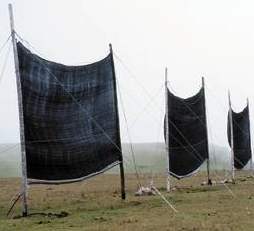
Dew HarvestingFresh water is of critical importance to most plant and animal life on land.Harvesting rainwater is not always practical or economical. An alternative is dew harvesting - or fog harvesting.
TechniquesDew forms over night - as the temperature drops, and water vapor in the air condenses onto surfaces it comes into contact with.A classical dew collector is a fine mesh, held perpendicular to the prevailing winds and suspended above guttering:
 Dew collector The mesh should allow moist air to move through it to some extent: an impenetrable barrier would reduce the speed of air next to its surface - thus slowing the processing of fresh air. The mesh should have a large surface area, with many potential condensation nucleii. It should be made of a relatively fine material that loses heat rapidly. A black fabric is normally preferred. U.V. stabilised polyethylene is sometimes used. The fabric should dump its load of dew as rapidly as possible. To that end, vertical fibres are more important than horizontal ones - and wind-driven motion is considered to be good. Height is desirable: the higher the collector, the faster the air moves past it, and the more dew is collected. Compared to a typical rain water collector, this type of dew collector has a small footprint on the ground. Some dew may also condense onto metal roof structures - from where it can be collected along with any rainwater.
PlantsPlants are experts at dew harvesting.
Mosses have interesting dew harvesting technology. They use aerial condensation nuclei that fold and collapse under the weight of condensed water.
Spider silkSpider webs collect dew well - although that is not their intended function.
 Spider webs
Links
|


